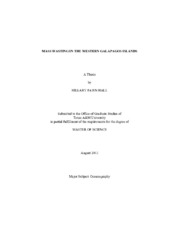| dc.description.abstract | Oceanic island volcanoes such as those in the Hawaiian, Canary and Galapagos Islands are known to become unstable, causing failures of the subaerial and submarine slopes of the volcanic edifices. These mass wasting events appear to be the primary source of destruction and loss of volume of many oceanic islands, but our knowledge of mass wasting is still rudimentary in many seamount and island chains. To better understand mass wasting in the western Galapagos Islands, multi-beam bathymetry and backscatter sidescan sonar images were used to examine topography and acoustic backscatter signatures that are characteristic of mass wasting. Observations show that mass wasting plays an important role in the development of Galapagos volcanoes. While volcanic activity continues to conceal the submarine terrain, the data show that four forms of mass wasting are identified including debris flows, slumps sheets, chaotic slumps, and detached blocks. A total of 23 mass wasting features were found to exist in the western Galapagos Islands, including fourteen debris flows with one that incorporated a set of detached blocks, seven slump sheets, and one chaotic slump. Some of the indentified features have obvious origination zones while the sources of others are not clearly identifiable. Approximately 73 percent of the surveyed coastlines are affected by slumping on the steep upper slopes and ~64 percent are affected by debris flows on the lower slopes. Unlike the giant landslides documented by GLORIA imagery around the Hawaiian Islands, the western Galapagos Islands appear to be characterized by small slump sheets existing along the steep shallow submarine flanks of the island and by debris flows that are flanked by rift zones and extend off the platform. This study indicates that submarine mass wasting is widespread in the western Galapagos, suggesting that the production of small-scale downslope movement is part of the erosive nature of these oceanic volcanic islands. | en |


